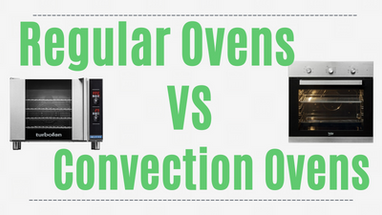Posted by Andrea G on 22nd Jun 2022
Regular Ovens Vs Convection Ovens
You want to buy a new oven for your business, but you do not know which one to decide on. Since there are many types on the market, you are not sure which one best suit your needs and budget! You do not know the difference between regular or convection ovens! Keep reading our guide to regular vs convection ovens, knowing the pros and cons can help you make the best decision for your kitchen.
Choosing the right oven depends entirely on cooking habits, daily production, type of business, and the size of your kitchen. Both regular and convection ovens have advantages and disadvantages worth considering. Identifying your differences is a good starting point.
Regular Oven: is an indispensable kitchen equipment that can cook, roast, and heat food using natural gas or electricity. You can cook meat or stews, bake cakes, bread, and other desserts.

In regular ovens, the heat source is fixed and usually works at the bottom of the oven. Heat rising from below can produce small pockets of hot and cold air, which can lead to uneven cooking. As you turn up the heat, the top of the food cooks faster than the middle. This cooking method is usually ideal for grilling and baking.
Pros of Regular Ovens
- Most recipes are written for regular ovens, so can be used with no changes.
- The technology is familiar, so they are easier for most people to use.
- Can accommodate a wide range of baking from pies and cookies to pastries and cakes.
- Regular ovens usually cost less than convection ovens.
Cons of Regular Ovens
- Does not have any mechanism to circulate heat so food can cook unevenly. Cooking more than one dish lowers its temperature and increases cooking time.
- Food can take longer to cook, potentially slowing down the kitchen.
- Uses more electricity or gas to preheat and maintain at temperature, which may increase energy use and cost.
Convection Ovens: also called fan-assisted ovens. They incorporate a fan that circulates the heat generated by the resistance of the oven. This function usually results in even faster cooking. Radiant heat sources at the bottom and top of the oven ensure better heat transfer and cooking speed. Some convection ovens have heating elements located in an outdoor enclosure and away from the food. Cooking temperature requirements can also be lower with the combination of thermostats and heating elements inherent in convection ovens.

Pros of Convection Ovens
- Cook more evenly, browns and crisps, and stay tender and moist inside.
- Shorter cooking times mean less energy is used, and food gets out faster.
- Faster heating process
- Can cook multiple dishes, making the kitchen more efficient.
Cons of a Convection Oven
- Shorter cooking times mean that recipes need to be adjusted.
- Bread, pastries, and cakes do not rise as well as a convection oven.
- Too many dishes can lead to longer cooking times.
- Convection ovens may cost more than a regular oven.
Major differences between them
- The most distinctive feature of a regular oven is its heating element located at its bottom. Although this results in uneven cooking of food, this method is often used in baking pastry and roasting several kinds of food.
- A convection oven is known for its built-in fan, which is responsible for circulating heat within the oven chamber. The heating elements are at the top and bottom of the convection oven. These features often result in even cooking and a faster heating and cooking process compared to a regular oven.
- The most basic regular ovens use timers and have simple heating controls that run continuously at preset heating levels. Instead, convection ovens rely on thermostats to sense the amount of heat needed to cook, so they're also energy efficient
- The environment of convection ovens is drier than in regular ovens
Consider this article when making your choice of the oven. Since both types ovens have pros and cons, this decision should not be taken lightly. Study the type of menu you want to serve and depending on which you decide, and if space allows it, it would be a clever idea to get both types of ovens since convection ovens are perfect for roasting, but not so good for pastry.
Remember that once you have chosen the oven that best suits your needs, you must find a kitchen equipment supplier to guide you and help you in the process. Visit our website Leasetaurant.com or call us at 888-980-6951. As always, the team at Leasetaurant is happy to answer any further questions you may have.



